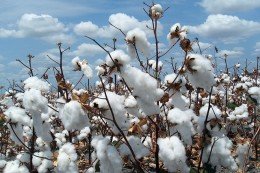
COTTON IS a soft, fluffy staple fiber that grows in a boll. Cotton plant belongs to the genus “Gossypium” in the family of “Malvaceae.” The fiber is almost pure cellulose. The cotton plant is a shrub native to tropical and subtropical regions around the world, including the America, Africa, and India. The greatest diversity of wild cotton species is found in Mexico, followed by Australia and Africa. Cotton is grown commercially in more than 70 different countries, mostly in the longitudinal band between 37°N and 32°S. Cotton is especially adapted to the semi-arid and arid environment where it is either grown under rain-fed conditions or on irrigated land.
Cotton is grown primarily for its fiber which is used as a raw material in textiles and to produce vegetable oil. Cotton is heavily traded agricultural commodity with over 150 countries involved in either exporting or importing the cotton. It is the most widely used natural fiber cloth in fabrics these days. Current estimates for world production are about 25 million tonnes (110 million bales) annually.
Pakistan stands at fourth in the list of top cotton producing countries. China is the biggest producer as well as consumer but United States exports most of its production and processes a small percentage. In some countries like Pakistan, India, China or Turkey, cotton production is going to be affected by soil degradation, water scarcity, and climate change.
According to “Global Climate Risk Index 2014” released by the German Watch Institute; Pakistan is ranked third after Haiti and the Philippines in the ranking of countries most affected by climate change. Cotton production has affected the climate and is also being affected by the climate change these days.
The most devastating factor remained the monsoon which destroys the cotton crop. Different operations during the production of cotton at field level related to growth, plant protection and harvesting results in emissions of different harmful gases. These gas emissions are one of the major causes of global warming that increases temperature worldwide. Other than cultural practices of cotton production, further processing poses threat to climate and these operations include ginning, bale formation, its transportation to textile mill after that bales are undergo different stages to come into final shape of fine fabric. These all processes need energy that cost much more to climate that is why we are on the front of climate change issue.
Those regions which are producing cotton close to 40º C would seem to be at a disadvantage. They already have longer growing seasons and any rise in temperature could induce sterility and inhibit boll formation. The plant breeders in such countries will have to focus on heat tolerance induction in cotton plant. Cotton is successfully grown at 28.2º C in China, 37.6º C in India, 36.8º C in Pakistan, and 41.8º C in Sudan.
It has not been established that 41.8º C is the upper limit, but the recent experiences in many countries particularly in India, Pakistan and the Syrian Arab Republic has shown that heat stress is a big constraint to increasing yields. If global warming continues; Turkey, China, United States, Australia and Argentina could experience a positive impact on yields as a result of a rise in temperatures of only a few degrees Celsius. Cotton yields are expected to increase with limited increase in temperature and carbon di oxide in some countries while in the other will result in flower and fruit shedding.
Cotton has certain resilience to high temperature and drought due to its vertical tap root but it is sensitive to water availability particularly at flowering and boll formation. Climate change impacts on rainfall are regionally diverse.
Pakistan is likely to be the country that will suffer most from climate change as far agriculture is concerned. In Pakistan, agriculture is highly dependent on irrigation water derived from the Indus River, which will carry less water as the Himalayan and Tibetan glaciers and snowfields diminish in size.
The Indus River is very important to agriculture in Pakistan as cotton production already takes place in sub-optimal conditions with respect to high temperatures. Therefore, further increases in temperature during the growing season will depress yield. Recent floods in 2014 have given us a wakeup call to understand the gravity of the situation. This is a clear picture of climate change which is going to become more intensive in near future. In 2010, flooding in Pakistan heightened the awareness of climate impacts, when water covered one-fifth of the country, directly affecting about 20 million people and destroying their ability to live and be productive.
Pakistan economy is highly dependent on agriculture and if certain measures are not taken, the country may bother genuine threats. In order to protect agriculture from climate hits particularly monsoon intensive rain impacts on cotton fruit and quality; farmers with the help of experts have to reconsider the date of sowing the cotton at least two months prior the current so that the product is harvested before the monsoon hits and to use the precision agricultural technologies like Global Positioning System (GPS), Geographic Information System (GIS) in terms of fertilizer, water application and plant protection so that environmental pollution can be minimized.
The author can be reached at abbasfarid2257@gmail.com